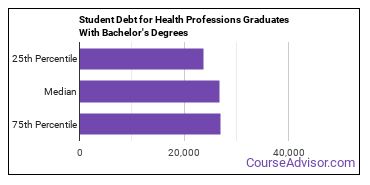Bachelor’s Degrees in Other Health Professions
Featured schools near , edit
Education Levels of Health Professions Majors
In 2020-2021, 4,516 earned their bachelor's degree in health professions. This makes it the 85th most popular bachelor's degree program in the country.
The following table shows the number of diplomas awarded in health professions at each degree level.
| Education Level | Number of Grads |
|---|---|
| Bachelor’s Degree | 4,516 |
| Associate Degree | 1,296 |
| Master’s Degree | 989 |
| Undergraduate Certificate | 535 |
| Basic Certificate | 376 |
| Graduate Certificate | 155 |
| Doctor’s Degree | 117 |
Earnings of Health Professions Majors With Bachelor’s Degrees
The median salary for graduates holding a bachelor's degree in health professions is $30,839. However, this can depend on a number of factors, such as where you live and the number of years experience you have. To get a better picture, earnings for this category of people can range from a low of $27,868 to a high of $40,637.

Student Debt
The median student debt for graduates holding a bachelor's degree in health professions is $26,763. The length of time it takes you to graduate and what college you attend can affect this number quite a bit. The chart below shows the range of accumulated debt loads. On the high side of the range, $27,000 is the debt load, and the debt load on the low side is $23,804.

Those students who are paying back their debt on a 10-year repayment plan have a median monthly payment of $364.
Student Diversity
More women than men pursue their bachelor's degree in health professions. About 78.4% of graduates with this degree are female.
| Gender | Number of Grads |
|---|---|
| Men | 976 |
| Women | 3,540 |

The racial-ethnic distribution of health professions bachelor’s degree students is as follows:
| Race/Ethnicity | Number of Grads |
|---|---|
| Asian | 265 |
| Black or African American | 452 |
| Hispanic or Latino | 435 |
| White | 2,892 |
| International Students | 157 |
| Other Races/Ethnicities | 315 |

Most Popular Health Professions Programs for Bachelor’s Degrees
There are 126 colleges that offer a bachelor’s degree in health professions. Learn more about the most popular 20 below:
Quinnipiac University tops the list of the most popular school in the U.S. for health professions majors who are seeking their bachelor's degree. Roughly 9,700 attend the school each year. The average in-state tuition for full-time undergraduates is $48,680 per year, while in-state graduate students, on average, pay $19,530 per year. During the 2020-2021 academic year, 353 people received their bachelor's degree in health professions from Quinnipiac. Of these students, 83% were women and 25% were members of underrepresented racial-ethnic groups.
Oakland University comes in at #2 on our list of the most popular colleges offering bachelor's degrees in health professions. Roughly 18,500 attend the school each year. The average in-state tuition for full-time undergraduates is $15,135 per year, while in-state graduate students, on average, pay $19,323 per year. For the 2020-2021 academic year, 285 bachelor's degrees were handed out to health professions majors at Oakland. About 74% of this group were women, and 17% were students from an underrepresented racial-ethnic group.
The 3rd most popular school in the country for health professions majors who are seeking their bachelor's degree is Grand Valley State University. Each year, around 23,300 students seeking various degrees attend the university. The average in-state tuition for full-time undergraduates is $13,900 per year, while in-state graduate students, on average, pay $17,904 per year. During the 2020-2021 academic year, 253 people received their bachelor's degree in health professions from GVSU. Around 18% of these students were from an underrepresented racial-ethnic group, and 84% were women.
Boise State University comes in at #4 on our list of the most popular colleges offering bachelor's degrees in health professions. Each year, around 24,000 students seeking various degrees attend the university. The average in-state tuition for full-time undergraduates is $5,532 per year, while in-state graduate students, on average, pay $7,110 per year. During the 2020-2021 academic year, 201 people received their bachelor's degree in health professions from Boise State. About 76% of this group were women, and 28% were students from an underrepresented racial-ethnic group.
The 5th most popular school in the country for health professions majors who are seeking their bachelor's degree is Tulane University of Louisiana. Each year, around 13,900 students seeking various degrees attend the university. The average in-state tuition for full-time undergraduates is $56,684 per year, while in-state graduate students, on average, pay $59,000 per year. During the 2020-2021 academic year, 185 people received their bachelor's degree in health professions from Tulane. Of these students, 85% were women and 25% were members of underrepresented racial-ethnic groups.
George Mason University is the 6th most popular school in the nation for students seeking a bachelor's degree in health professions. Each year, around 38,500 students seeking various degrees attend the university. The average in-state tuition for full-time undergraduates is $9,510 per year, while in-state graduate students, on average, pay $13,035 per year. During the 2020-2021 academic year, 128 people received their bachelor's degree in health professions from GMU. Of these students, 86% were women and 70% were members of underrepresented racial-ethnic groups.
The 7th most popular school in the country for health professions majors who are seeking their bachelor's degree is Gannon University. Each year, around 4,200 students seeking various degrees attend the university. The average in-state tuition for full-time undergraduates is $34,575 per year, while in-state graduate students, on average, pay $19,980 per year. The health professions program at Gannon University awarded 125 bachelor's degrees during the 2020-2021 school year. Of these students, 85% were women and 6% were members of underrepresented racial-ethnic groups.
The 8th most popular school in the country for health professions majors who are seeking their bachelor's degree is Wayne State University. Each year, around 26,200 students seeking various degrees attend the university. The average in-state tuition for full-time undergraduates is $13,532 per year, while in-state graduate students, on average, pay $16,920 per year. For the 2020-2021 academic year, 122 bachelor's degrees were handed out to health professions majors at Wayne State. About 76% of this group were women, and 14% were students from an underrepresented racial-ethnic group.
Clemson University is the 9th most popular school in the nation for students seeking a bachelor's degree in health professions. Each year, around 26,400 students seeking various degrees attend the university. The average in-state tuition for full-time undergraduates is $14,118 per year, while in-state graduate students, on average, pay $10,600 per year. During the 2020-2021 academic year, 113 people received their bachelor's degree in health professions from Clemson. Around 8% of these students were from an underrepresented racial-ethnic group, and 80% were women.
Mercy College is the 10th most popular school in the nation for students seeking a bachelor's degree in health professions. Each year, around 9,500 students seeking various degrees attend the university. The average in-state tuition for full-time undergraduates is $19,920 per year, while in-state graduate students, on average, pay $16,974 per year. For the 2020-2021 academic year, 109 bachelor's degrees were handed out to health professions majors at Mercy. About 84% of this group were women, and 74% were students from an underrepresented racial-ethnic group.
The 11th most popular school in the country for health professions majors who are seeking their bachelor's degree is University of Cincinnati - Main Campus. Roughly 40,800 attend the school each year. The average in-state tuition for full-time undergraduates is $10,099 per year, while in-state graduate students, on average, pay $13,224 per year. The health professions program at University of Cincinnati - Main Campus awarded 105 bachelor's degrees during the 2020-2021 school year. Of these students, 78% were women and 19% were members of underrepresented racial-ethnic groups.
Old Dominion University comes in at #11 on our list of the most popular colleges offering bachelor's degrees in health professions. Roughly 24,200 attend the school each year. The average in-state tuition for full-time undergraduates is $7,029 per year, while in-state graduate students, on average, pay $10,207 per year. For the 2020-2021 academic year, 105 bachelor's degrees were handed out to health professions majors at Old Dominion. About 81% of this group were women, and 59% were students from an underrepresented racial-ethnic group.
Fort Hays State University is the 13th most popular school in the nation for students seeking a bachelor's degree in health professions. Each year, around 15,000 students seeking various degrees attend the university. The average in-state tuition for full-time undergraduates is $4,140 per year, while in-state graduate students, on average, pay $3,726 per year. During the 2020-2021 academic year, 101 people received their bachelor's degree in health professions from FHSU. Around 2% of these students were from an underrepresented racial-ethnic group, and 83% were women.
American Public University System comes in at #14 on our list of the most popular colleges offering bachelor's degrees in health professions. Roughly 50,000 attend the school each year. The average in-state tuition for full-time undergraduates is $6,840 per year, while in-state graduate students, on average, pay $6,660 per year. During the 2020-2021 academic year, 88 people received their bachelor's degree in health professions from American Military University. Around 47% of these students were from an underrepresented racial-ethnic group, and 75% were women.
The 15th most popular school in the country for health professions majors who are seeking their bachelor's degree is LIU Post. Each year, around 15,000 students seeking various degrees attend the university. The average in-state tuition for full-time undergraduates is $37,296 per year, while in-state graduate students, on average, pay $22,047 per year. The health professions program at LIU Post awarded 80 bachelor's degrees during the 2020-2021 school year. Of these students, 78% were women and 56% were members of underrepresented racial-ethnic groups.
The 16th most popular school in the country for health professions majors who are seeking their bachelor's degree is Lock Haven University. Each year, around 3,100 students seeking various degrees attend the university. The average in-state tuition for full-time undergraduates is $7,716 per year, while in-state graduate students, on average, pay $9,288 per year. For the 2020-2021 academic year, 77 bachelor's degrees were handed out to health professions majors at LHU. About 70% of this group were women, and 10% were students from an underrepresented racial-ethnic group.
Saint Joseph's University comes in at #16 on our list of the most popular colleges offering bachelor's degrees in health professions. Each year, around 6,700 students seeking various degrees attend the university. The average in-state tuition for full-time undergraduates is $47,740 per year, while in-state graduate students, on average, pay $18,144 per year. For the 2020-2021 academic year, 77 bachelor's degrees were handed out to health professions majors at St. Joe's. Around 30% of these students were from an underrepresented racial-ethnic group, and 87% were women.
University of Maryland - Baltimore County comes in at #18 on our list of the most popular colleges offering bachelor's degrees in health professions. Each year, around 13,400 students seeking various degrees attend the university. The average in-state tuition for full-time undergraduates is $8,878 per year, while in-state graduate students, on average, pay $12,222 per year. For the 2020-2021 academic year, 76 bachelor's degrees were handed out to health professions majors at UMBC. About 78% of this group were women, and 76% were students from an underrepresented racial-ethnic group.
The 19th most popular school in the country for health professions majors who are seeking their bachelor's degree is King's College. Roughly 2,300 attend the school each year. The average in-state tuition for full-time undergraduates is $38,822 per year, while in-state graduate students, on average, pay $46,341 per year. The health professions program at King's College awarded 73 bachelor's degrees during the 2020-2021 school year. Around 11% of these students were from an underrepresented racial-ethnic group, and 77% were women.
University of Central Arkansas is the 20th most popular school in the nation for students seeking a bachelor's degree in health professions. Roughly 10,300 attend the school each year. The average in-state tuition for full-time undergraduates is $6,870 per year, while in-state graduate students, on average, pay $5,063 per year. The health professions program at University of Central Arkansas awarded 72 bachelor's degrees during the 2020-2021 school year. Of these students, 68% were women and 38% were members of underrepresented racial-ethnic groups.
Explore Major by State
Alabama
Arkansas
Connecticut
Florida
Idaho
Iowa
Louisiana
Massachusetts
Mississippi
Nebraska
New Jersey
North Carolina
Oklahoma
Rhode Island
Tennessee
Vermont
West Virginia
Related Majors
Below are some popular majors that are similar to health professions that offer bachelor’s degrees.
| Major | Annual Degrees Awarded |
|---|---|
| Nursing | 165,538 |
| Public Health | 19,511 |
| Health/Medical Admin Services | 19,391 |
| Health Sciences & Services | 18,866 |
| Communication Sciences | 11,434 |
References
*The racial-ethnic minority student count is calculated by taking the total number of students and subtracting white students, international students, and students whose race/ethnicity was unknown. This number is then divided by the total number of students at the school to obtain the percentage of racial-ethnic minorities.
- College Factual
- National Center for Education Statistics
- O*NET Online
- Bureau of Labor Statistics
- Image Credit: By https://upload.wikimedia.org/wikipedia/commons/b/b5/NY_College_of_Health_Professions_Massage_Therapy_Class.jpg under License
More about our data sources and methodologies.
Featured Schools
 Request Info
Request Info
|
Southern New Hampshire University You have goals. Southern New Hampshire University can help you get there. Whether you need a bachelor's degree to get into a career or want a master's degree to move up in your current career, SNHU has an online program for you. Find your degree from over 200 online programs. Learn More > |


















